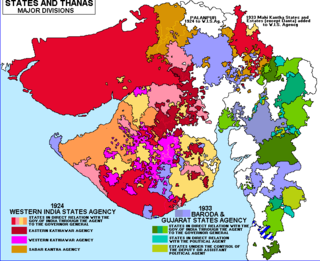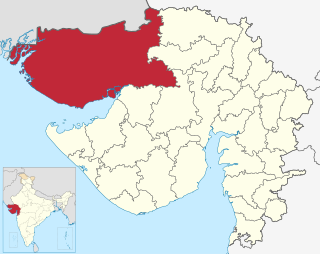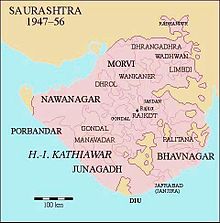
Kathiawar is a peninsula, near the far north of India's west coast, of about 61,000 km2 (23,500 sq mi) bordering the Arabian Sea. It is bounded by the Gulf of Kutch in the northwest and by the Gulf of Khambhat in the east. In the northeast, it is connected to the rest of Gujarat and borders on the low, fertile hinterland of Ahmedabad. It is crossed by two belts of hill country and is drained radially by nine rivers which have little natural flow aside from in monsoon months, thus dams have been built on some of these. Kathiawar ports have been flourishing centres of trade and commerce since at least the 16th century.

Saurashtra, also known as Kathiawar, is a peninsular region of Gujarat, India, located on the Arabian Sea coast. It covers about a third of Gujarat state, notably 11 districts of Gujarat, including Rajkot District. It was formerly a state of India before it merged with Bombay state. In 1961 it separated from Bombay and joined Gujarat.

Jadeja is a Rajput clan that inhabits the Indian state of Gujarat and the Tharparkar district of Sindh, Pakistan. They originated from Sammas of Sindh, a pastoral group, and laid a claim on the Rajput identity after marriages with Sodha Rajput women by adopting a process called Rajputisation.

Halar (Haalaar) is a historical region of western India, located by the Gulf of Kutch coast on the northwestern area of Nawanagar, now Jamnagar, in Gujarat State, on Saurashtra peninsula, roughly corresponding to the present Jamnagar District, Devbhumi Dwarka district, Morbi District and Rajkot District.
Kotharia is a town in Rajkot district of Gujarat, which was a small princely state offshoot of the Rajkot state in the Saurashtra region of Gujarat, part of the Bombay Presidency during British Raj.

Rajkot State was one of the princely states of India during the period of British rule. It was a 9-gun salute state belonging to the Kathiawar Agency of the Bombay Presidency. Its capital was in Rajkot, located in the historical Halar region of Kathiawar on the banks of the Aji River. Nowadays, Rajkot is the fourth largest city of Gujarat state.
Saurashtra Railway came into being in April, 1948 with the amalgamation of state railways like Bhavnagar State Railway, Gondal Railway, Porbandar Railway, Jamnagar & Dwarka Railway, Morvi Railway, Dhrangadhra Railway, Okhamandal State Railway, Junagadh State Railway, Baria State Railway, Rajpipla Railway etc.

Saurashtra State, formally known as United States of Kathiawar and later United States of Saurashtra, was a State of India that existed between 1948 and 1956, on Saurashtra alias Kathiawar peninsula, with Rajkot as its capital,

Kutch, also spelled Kutch or Kachchh and also historically known as the Kingdom of Kutch, was a kingdom in the Kutch region from 1147 to 1819 and a princely state under British rule from 1819 to 1947. Its territories covered the present day Kutch region of Gujarat north of the Gulf of Kutch. Bordered by Sindh in the north, Cutch State was one of the few princely states with a coastline.
Khengarji I (1510-1585) was an Indian ruler belonging to Jadeja clan of Rajputs. He was the ruler of Morbi from 1538-1585 and later became ruler of Cutch, assuming title of Rao of Cutch, ruling unified Cutch from 1548 to 1585.
The Morbi railway station belongs to the Western Railway of Rajkot Division. It is located in the Morbi district of Gujarat State.

The Rajkot–Wankaner section belongs to Western Railway of Rajkot Division in Gujarat State.

The Baroda, Western India and Gujarat States Agency was an agency of the Indian Empire, managing the relations of the Provincial Government of the Bombay Presidency with a collection of princely states.

Dhrol State was one of the 562 princely states of British India. It was a 9 gun salute state belonging to the Kathiawar Agency of the Bombay Presidency. Its capital was in the town of Dhrol, located in the historical Halar region of Kathiawar.
Rao Pragmalji I was the Rao of Cutch belonging to Jadeja Rajput dynasty, who ruled Princely State of Cutch as from 1698 to 1715. He established current lineage of rulers of the state in 1698.

The history of Kutch, (kachchh) a region in the extreme west of the western Indian state of Gujarat, can be traced back to prehistorical times. There are several sites related to Indus valley civilization in region and is mentioned in Hindu mythology. In historical times, Kutch is mentioned in Greek writings during Alexander. It was ruled by Menander I of Greco-Bactrian Kingdom which was overthrown by Indo-Scythians followed by Maurya Empire and Sakas. in the first century, it was under Western Satraps followed by Gupta Empire. By fifth century, Maitraka of Valabhi took over from which its close association with ruling clans of Gujarat started. Chavdas ruled the eastern and central parts by seventh century but then came under Chaulukyas by tenth century. After fall of Chaulukya, Vaghelas ruled the state. Following conquest of Sindh by Muslim rulers, Rajput Samma started moving southwards to Kutch and ruled western regions initially. By tenth century, they controlled significant area of Kutch and by thirteenth century they controlled whole of Kutch and adopted a new dynastic identity, Jadeja.
Jalia Devani is a former Rajput non-salute princely state on Saurashtra peninsula, in Gujarat, western India.
Kotda Nayani is a village and former non-salute princely state on Saurastra peninsula in Gujarat, western India.
Ramanka is a village and former salute Rajput princely state on Saurashtra Gujarat, western India.
Jethwa dynasty was a dynasty that ruled over present day Gujarat region of India from 7th century AD till middle of 20th century, when India became independent. It was a Rajput dynasty ruled by Jethwa clan of Rajputs.














